Hazra Kalibari embodies a temple complex that many New Towner’s would probably be unaware of even though many of them cross the precincts on a regular basis. Close to New Town Action Area III’s Karigori Bhawan is a little sliver of land that makes up the precinct of the ancient Hazra Kalibari. Across the road the sparkling and towering complexes of Uniworld and others loom large. Unknown to many here lies a boundary of the North and the South 24 Parganas, and the temple complex situated in South 24 Parganas largely represents that escaped the swathe of HIDCO’s acquisition purely on geographic boundaries. Some prudent and well heeled individuals have been quick to cash in on this but that is another story in itself.
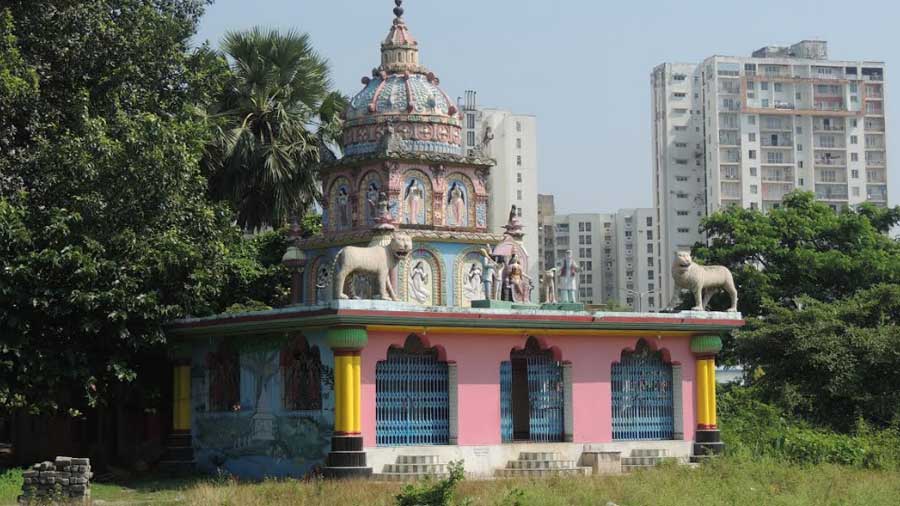
The Bondevi temple within the complex
A slice of the past in a busy city
The Hazra Kalibari is not small by any chance and the spires of the temples are clearly visible as one passes down this stretch of New Town’s wide avenues. Within the complex lies the main mandir presided over by the deity known as Hazra Kali and Shamshan Kali along with the Shivalinga. There is also Bondebi’s Mandir guarded as it is by the two tiger sculptures and those of other deities while the Radha Gobindo Mandir greets all those entering from towards the main road. A new Jagannath Mandir is also on the verge of getting ready for opening. Apart from this there is also the small Mandir to Lord Yama beside the pond known as Dudpukur. A priest appointed by the committee oversees and performs the regular pujas of the complex.
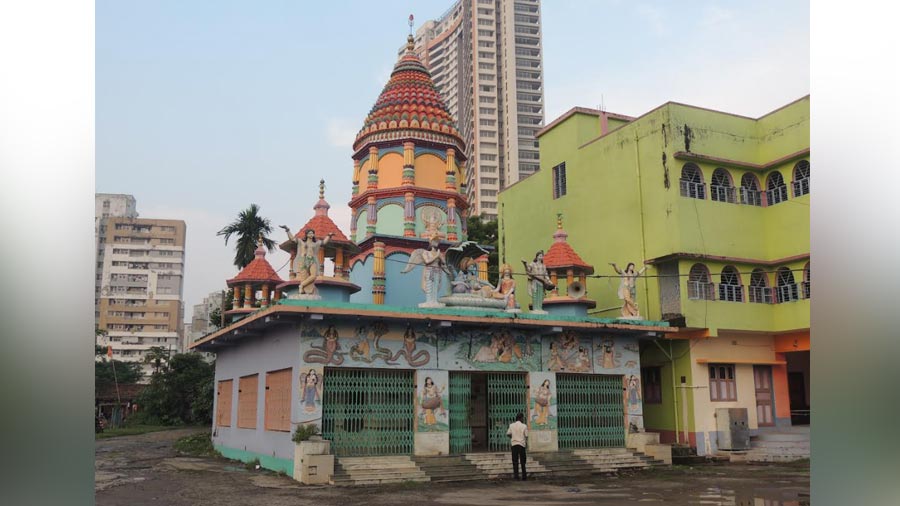
The Radha Gobindo temple in te premises
Bapi Mondal, the present secretary of the Hazra Kali Seba Samity and also the government registered Hazra Kali Seva Samity Trust spoke at length to My Kolkata highlighting not only the facets from the past but also the present scenario in the context of the mandir complex. He states, “This temple complex can be dated back to almost 450 years. Goddess Kali whom you witness today is depicted here in her calm form. Unlike the more prevalent form Goddess mostly is depicted with her tongue extended, that is also synonymous with what is known as Shamshan Kali. The main puja here is the Nil Puja which takes place in Chaitra Sankranti in the Bengali Chaitra month. During that particular time anywhere close to a lakh and a half people can be seen in the premises. People from all over the country and especially from the neighbouring states such as UP, Bihar and Odisha come visiting. On the day of ‘Nil Puja,’ close to 150 goats are sacrificed in honour of the goddess and also on account of vows made before her. The heads of the sacrificed animals are also revered and utilised for some religious practises in the name of ‘demons and ogres’ or ‘Dwaitya Danavs’ that are carried out here as a part of the annual event. The rest of the bodies are then given over to the representatives of neighbouring villages to be consumed as ‘prasad’. It may be noted that the meat is distributed not only among the villagers of Pachuri where our Mandir is situated but is distributed among almost 15 other nearby villages.”
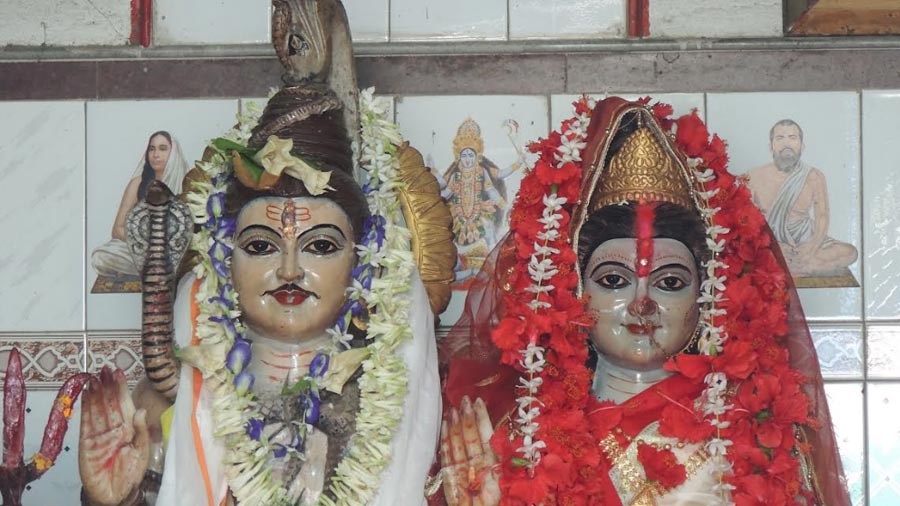
The idols in the inner sanctum of the Kali bari
A history going back centuries
Elaborating on the historical aspects Mondal stated, “It is said that even Rani Rashmoni had come and paid her obeisance to the deity here. Her present day ancestor has expressed a wish to be here for the celebrations that will happen in the month of Chaitra. We are currently involved in the construction of the temple for Lord Jaggannath which is being carried out with a budget of almost three crores. It is our desire and wish that the new temple will be inaugurated after Makar Sankranti next year.
The history of Hazra Kalibari can be traced back to centuries and this is the name with which successive generations have known the complex by. Incidentally, Hazra is another name for Mahadev or Lord Shiva and there are many parallels here that are similar to the famous temple of Tarakeshwar. There is also the Dudpukur, and every year after the completion of the pujas at Tarakeshwar, the temple’s head priest announces before one and all that Lord Shiva would now be progressing towards Hazra Kalibari Kalatala in Pachuri. That is the exact moment when the festivities and the puja’s begin here.
Explaining the complex’s position in time, Mondal continues, “Hazra Kalibari’s origins lie in folklore but the main temple and the first temple of prominence in the precinct is of course the Hazra Kalibari itself. According to prevalent theories, the mandir that we see today was once situated in a dense wooded area beside which flowed the ancient Bidyadhari river which today is found in the Sunderbans. It is said in ancient times, a devotee was passing by these desolate and terrifying locales. Tired as he was he had dozed off in the shade of the Banyan trees and as he hovered between slumber and sense he was able to see God in his dreams. Even in that sort of a state the devotee had asked God (Lord Shiva) to show his presence before the mortals. Lord Shiva it is said had then asked him to prepare a pedestal or thaan with mud from the nearby Dudpukur. Soon as that was done the Lord’s footprints emerged on the same and according to folklore the prints were much bigger than normal human footprints would be. That was how the worship of Lord Shiva had begun here. As we have been told there was initially a small earthen hut that served as the mandir. With the passage of time a more permanent mandir came into existence. The mandir that you see today came into being almost 28 years earlier and this happened only after the committee looking after the well being of the temple came into existence.”

The revered tree which marks the exact spot where the earthen mound from the legend was positioned
An amalgamation of cultural influences
Explaining the presence of the other temples in the complex Mondal added, “As the area came well under the geographical demarcations of Bengal’s Sunderbans it was quite expected that the local populace would want their lives to be protected from the wild animals namely tigers and other such. This was the reason why Bondevi’s temple came up.
Sakhididi, among the senior-most individuals who gave up everything for the care and well being of the temples, was the first to begin Harinam Sankirtan here. Prior to her demise she donated all her wealth and property to the temple here and her idol can be seen within the precincts. Radha Gobindo is worshipped in the temple which has been built by the committee. Shiva Chaturdoshi that is celebrated in the Bengali month of Falgun is when night long rituals of Harinam Kirtan are observed here, and in course of this prasad is distributed among at least 60,000 families of the locality.
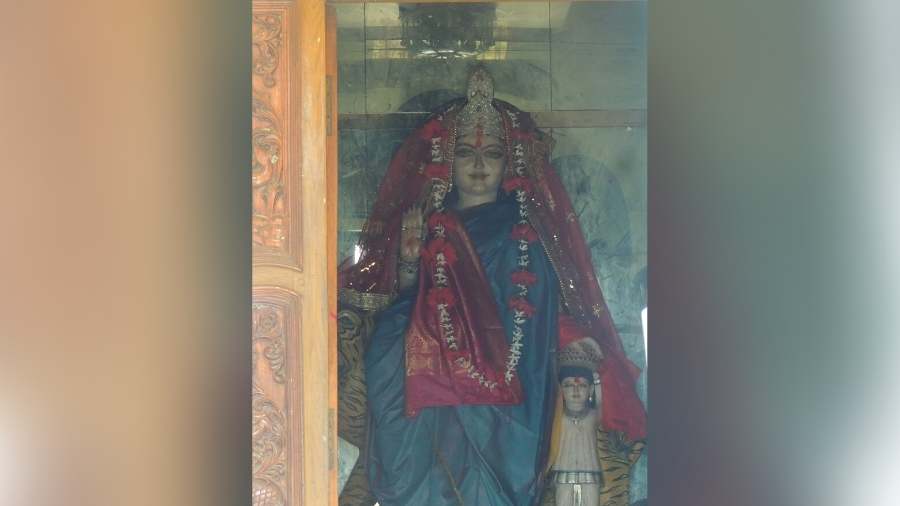
The Bondebi idol
A long time ago, the whole area had cremation/burial grounds or was a shashan. The bodies of individuals who had untimely deaths either through illnesses, suicide or even snake bites and such were either cremated or buried here. That is probably why there is an idol of Shamshan Kali seen beside the idols of Hazra here in the main mandir. Her puja is held in the Bengali Poush month.
Much like what is seen at the temple in Tarakeshwar is witnessed here and thousands from all over Bengal and elsewhere line up here at the Shiv Mandir to pour water on the deity’s head that they have carried hundreds of kilometres. The complex hosts four or five major events namely Shiva Chaturdoshi, Nil Puja, Pous Mela and for that a very healthy footfall of devotees is registered throughout the year. Apart from the religious observances, the mandir committee also takes part in distributing warm clothes, food and other items among the needy of society besides organising health camps and eye check-up camps, blood donation camps and more. In the recent past, the committee has had to battle HIDCO to save 11 bighas of land from being taken over as this happens to be the land where the melas are held every year and closure of the same would in all probabilities hamper age-old traditions of the mandir and all the locals here.
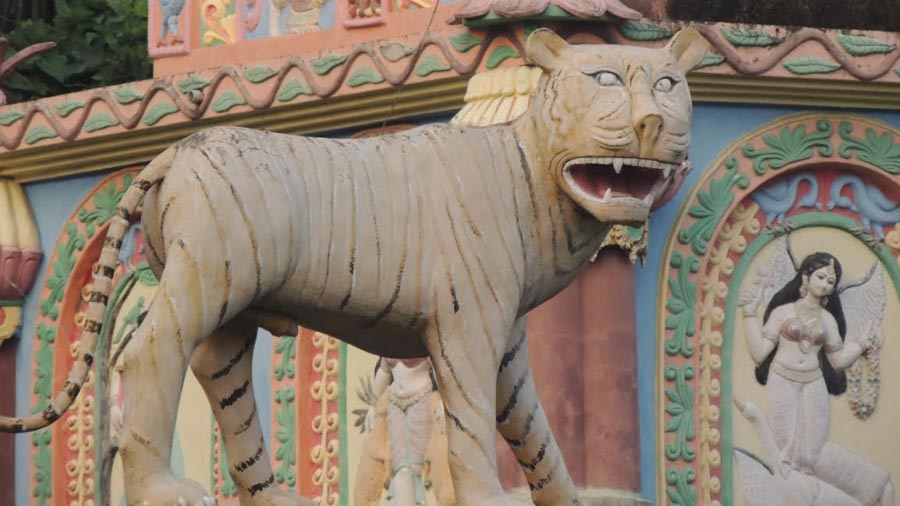
One of the two tigers that stand vigil over Bondebi's temple
Hidden treasures and unique rituals
Bapi Mondal spoke at length on the tantric elements that lie intertwined with the history of the complex. He explained, “There is an element of Tantric observances here in the mandir complex as these are aspects that invariably get associated with the complex being situated in the midst of a cremation and burial ground. Also Lord Shiva traditionally has a direct link to areas such as this. The skulls that are so prominently displayed in the mandir belong to those who had met accidental or untimely deaths. Their skulls have been preserved and are regularly worshipped here as a part of rituals associated with the appeasement of the demons that we refer to as dwaitya danavs. It may be noted that these skulls are no less than 450 to 500 years old. Social media platforms do have snippets that suggest rather exaggerated stories and even claims of treasures found here but we have raised our objections to such claims. It is however true that even recently not many would frequent these places alone and even during day times as it was generally accepted that there were the presences of ghosts and demons who resided here. The place does have strange characteristics and here I can recount something that I have witnessed with my own eyes. We have what is called the “Bojh” tree. It is a thorny tree and many individuals would climb on those and literally dance among the thorns but never get so much as a little scratch on their bodies. These are the sort of miracles that we ourselves have witnessed. There are even reports that speak of coins being attached to a person’s skin with safety pins and still no blood would flow out. The activities of the shashan ground have long since been stopped.

Murals on the Kalibari's walls depict scenes from mythology
Folklore, legends and peculiar tales
Hazra Kalibari’s relevance is intrinsically linked to the many folklores and strange happenings that have happened in the past. Shedding light on those Mondal added, “There are many stories or folklore that abound of the mandir and its many happening down the passage of time. According to one, a father and son duo had once taken up the task of digging a hole in the ground for the installation of a tube well. As they dug down they encountered what looked like a jar of coins but with ill intent they had stopped the work, covered the same and left without saying anything. Later that night they had returned but as they tried to retrieve the same it turned out that the jar also had snakes within. As they fled in abject fear they fell which resulted in their spines being broken and even today the survivor moves around with a bent back.”
Recounting other tales he added, “In another incident some thieves had attempted to steal the fishes from the Dudpukur in the dead of the night. The net of theirs somehow could not be pulled back and they had run to the priest for his forgiveness and also to retrieve their net from the pond. The priest seeing their plight had sprinkled some holy water from the mandir’s ghot and that somehow freed the net. Surprisingly, not a single fish got ensnared in that net. There is also the incident where a group of Muslim kids had caught a shoal fish from the pond and that fish had bled unbelievably when they were preparing to eat the same. They consumed the same and all developed severe skin afflictions thereafter. After fervent prayers and appeals to the gods here their conditions improved and they could return to normal lives. Besides these, there are many stories of strange individuals being seen beside the pond and also many more of miraculous recovery from diseases that are connected to this mandir and its surroundings. The tree behind the temple marks the spot where the original earthen pedestal had stood and this is also the spot where many come and make a pledge to the gods. Countless vouch that their wishes have always come true.”
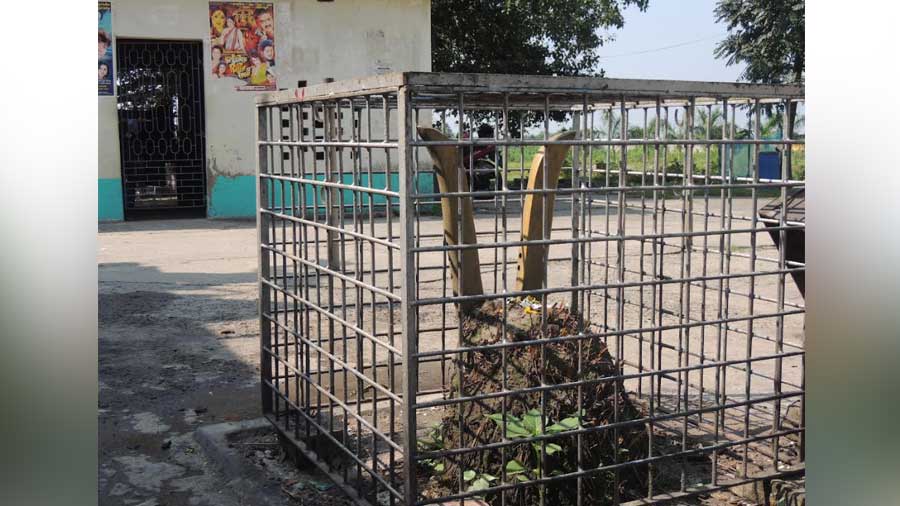
The altar for animal sacrifice
Keeping traditions alive
The tale and narration of this temple complex would also not be complete without a word on certain happenings that continued here until very recently. It must be mentioned that as a part of the traditional practices the bodies of sacrificed animals were tossed among the devotees in times of the festivals and entire villages join in to tear away a part of the flesh of the animal as blessings and victory spoils. Close to 10 teams from as many villages used to take part in this ritual that in all probability will appear macabre to many but it remains very real to what was observed here over the centuries. Those practices have stopped mainly on grounds of law and order, and on the request of the state government but many continue to sacrifice goats and the number of such sacrifices is well over 100 every year. In their defense of this particular practice, Bapi Mondal adds, “As a representative of the committee I would like to state that if animal sacrifice is removed completely by the government then we too will willingly comply, but till that day comes, we will continue to observe the rituals that we have been doing for so many years now. Since the restrictions imposed during the lockdown the practice of fighting for a piece of the sacrificed goat has been completely stopped.”
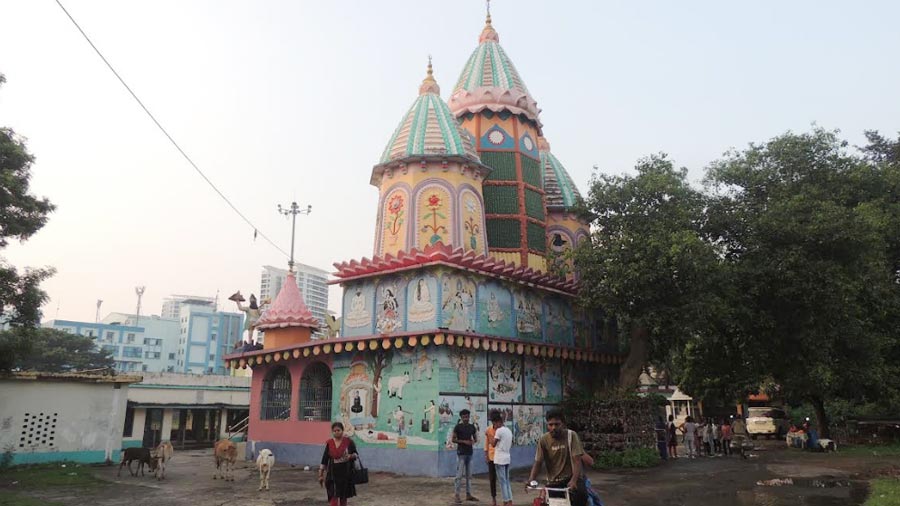
The temple stands juxtaposed against New Town’s highrises
By itself New Town is merely a few decades old or even less for that matter. The roads, complexes and even the population is all new. But even then, standing unmoved and proudly tall is the abode of Lord Hazra himself and his other divine companions. Here in the complex is the living embodiment of the fact that old does not always make way for the new but rather the new must learn to live with the old. That is what human history and human civilization is all about.
